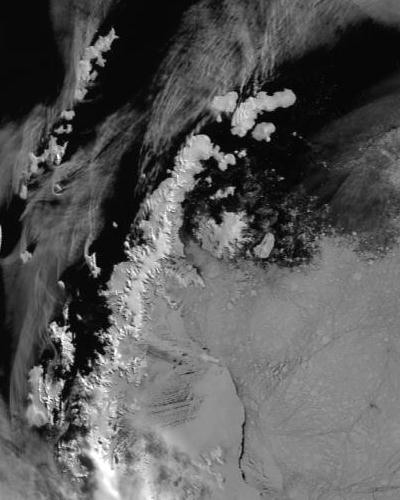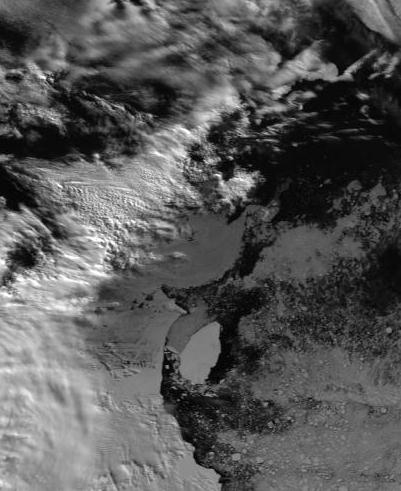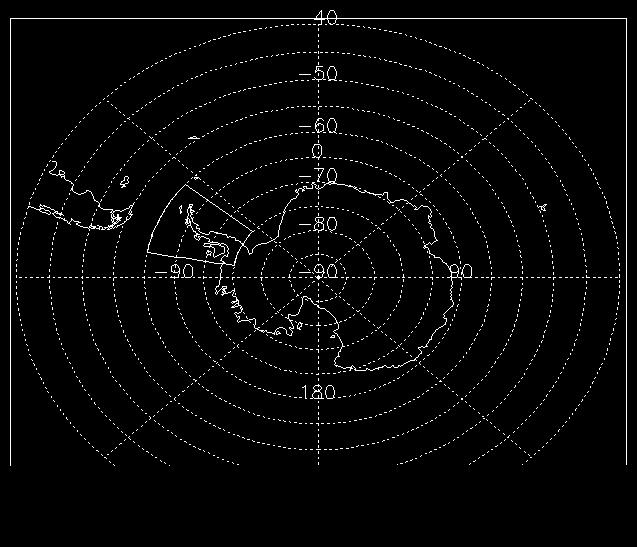British Antarctic Survey Press Release 1/95 27 February 1995
One Small Ice Shelf Dies, One Giant Iceberg Born
 Before
Before
 After
After
 Location map
Location map
The "before" picture is taken at 11 GMT, 9/Jan/95. It is before the iceberg calved, but after the iceshelf between James Ross ISland and the peninsula disintegrated. James Ross Island is the spidery-shaped island slightly above left of the center of the "before" image. The "after" is from 12 GMT, 12/Feb/1995. In this picture the iceberg has calved but has not moved far where it was calved. Both images are from near-visible channels.
The location map shows the Antarctic continent with the approximate region of the satellite pictures outlined.
The disintegration of an ice shelf and the calving of a new giant iceberg have dramatically changed the outline of Antarctica. Satellite images relayed to Cambridge from the British Antarctic Survey's (BAS) Rothera Research Station confirm that recent warming of the Antarctic Peninsula is having a major impact on the ice sheet covering this climatically sensitive region.
The ice shelf which formerly occupied Prince Gustav Channel and connected James Ross Island to the Antarctic Peninsula has disintegrated. For the first time in recorded history, James Ross Island is circumnavigable. The new iceberg calved from the Larsen Ice Shelf and measures 78 km x 37 km, (roughly the size of Oxfordshire), and is around 200 m thick.
Alerted by glaciologists 9000 miles away in Cambridge, scientists on board a BAS Dash 7 aircraft confirmed both the disintegration and calving, and reported a dense plume of ice fragments extending several hundred kilometres into the sea.
Speaking from Antarctica, chief geologist Dr Mike Thomson said, "Looking out of the aircraft window I was utterly amazed to see the dramatic and very recent changes to the Larsen Ice Shelf. In 25 years of Antarctic field work I have never seen anything like it."
These observations come hard on the heels of the disintegration of Wordie Ice Shelf on the west coast of the Antarctic Peninsula, also discovered by BAS scientists. There is now little doubt that the retreat of these ice shelves is, in the short-term, irreversible. The retreat is a result of a warming of the regional climate by 2.5ºC since the 1940's.
Glaciologist David Vaughan says, "There is no doubt that the climate on the Antarctic Peninsula has warmed significantly over the last few decades. What we're seeing now are changes only just working through to glaciers and ice sheets. It's an exciting time for glaciologists".
Over the next months and years the icebergs will drift north under the action of ocean currents and wind. The giant iceberg will melt rapidly once it crosses the Antarctic Convergence and enters warmer water. The calving of icebergs is normal within the lifecycle of ice shelves, which may be quiet for decades between calving events. Exceptionally the calving of one large iceberg may be a fore-runner of a more serious disintegration. It will take time before the implications are completely understood.
Issued by the BAS Press Office
Linda Capper 0223 251448
Bernard Moran 0223 251414
The BAS home page may be found at http://bsxisgb.nbs.ac.uk but may not be visible externally. Otherwise, you could try my home page
Contact Scientists: Glaciologists: David Vaughan 0223 251481; Dr Julian Paren Tel: 0223 251451; Dr David Peel Tel: 0223 251478; Meteorologist: Dr John King Tel: 0223 251487 Notes for editors: BETA Broadcast quality videotape, satellite images and maps are available from the Press Office.
Illustrations (available from the Press Office): Picture 1. Map of Antarctic Peninsula. Showing area covered by satellite images 1 and 2, and 1969 extent of Prince Gustav Channel ice shelf. It includes the position of British Antarctic Survey Faraday Research Station, whose meteorological records have shown a rise in mean annual air temperature of 2.5ºC since records began in 1940s.
Picture 3. Satellite Image. Image acquired at Rothera Research Station in January. This image shows the disintegration of the ice shelf in Prince Gustav Channel. Only a wisp of sea ice remains between the island and the Antarctic Peninsula.
Picture 3. Satellite Image. The February satellite image is partially covered by cloud but clearly shows the new iceberg. It is expected to be pushed North East by the wind and an ocean current called the Weddell Sea Gyre.
Background Notes:
Ice shelf. An ice shelf is the floating extension of the grounded ice sheet. It is composed of freshwater ice that originally fell as snow, either in situ or inland and brought to the ice shelf by glaciers. These are largely considered as permanent features.The larger Ronne and Ross ice shelves, cover areas the size of Spain and are up to 2000 m thick. It is thought that these ice shelves help restrain the inland ice sheet and so control sea level. A huge increase in air temperature would be required before these large ice shelves succumb to the same type of collapse as those on the Antarctic Peninsula. Such an event is thought unlikely in the near future.
Sea ice. Frozen sea water. Sea ice forms around the Antarctic Peninsula in the Autumn, forming a floating layer only a few metres thick. Most of it melts during the summer.
Prince Gustav Channel was discovered in 1903 by the Swedish Antarctic Expedition under Nordenskj”ld, who named it for Crown Prince Gustav of Norway. Until recently the ice shelf in Prince Gustav Channel provided a frequent route for sledging parties, from James Ross Island to the Antarctic Peninsula. Observations by glaciologists in Argentina and the UK showed that the retreat of its margins began decades ago, but this has accelerated and the recent disintegration has destroyed 700 km2 of ice shelf (roughly the size of the Isle of Man).
James Ross Island was discovered and roughly charted by Sir James Clark Ross, leader of a British Naval Expedition in 1842.
Larsen Ice Shelf was named for the Norwegian whaler, Capt. C.A. Larsen, who sailed, along the ice front in the ship Jason in 1893.
Climate data. Meteorological records from the BAS's Faraday Research Station have shown a rise in mean annual air temperature of more than 2.5øC since the 1940s. Climatologists have noted that the climate of this area is highly variable and is sensitive to the extent of the winter sea-ice.